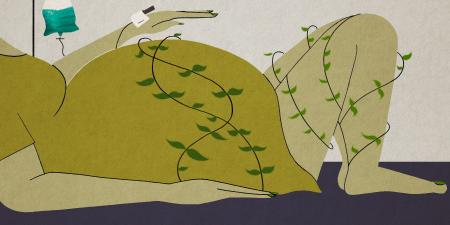In 1973, the American Psychiatric Association removed homosexuality from the second edition of the Diagnostic and Statistical Manual of Mental Disorders (DSM-II).1 Its removal, spurred by patient and social activism, marked a moment when activists took back a name that marginalized and pathologized them and reclaimed that name as an identity. Today, we physicians, our associations, and our institutions continue to use the power society has granted us to name—to name diseases, medical norms, risk factors, and statistical outliers. And with the label disease comes money for research and insurance reimbursement, treatment prioritization by our health care system, and numerous societal associations, both overt and covert. By defining obesity as a body mass index equal to or greater than 30 kg/m2, for example, we have given a name to the “obesity epidemic.”2 By defining hypertension as life threatening, we are suggesting that an asymptomatic but significant risk factor necessitates prevention, treatment, and elimination.3 By characterizing being without wrinkles as a medically attainable aesthetic,4 we are driving the medical pursuit of a specific beauty standard.
While the physician’s power to name seems prima facie beyond the scope of everyday practice, in reality, it is central to much of what a physician does daily—from diagnosing, to fighting insurance companies for coverage, to balancing the risks and benefits of treatment. When a physician examines comedones on a person’s face and calls them acne, that physician is designating that person as having a named disease and changing that patient’s skin bumps into a medical condition that can be treated with pills or creams. When a patient disagrees with that assessment, when she either feels pigeonholed by a diagnosis or not fully recognized in her illness, tensions can develop between patient and physician.
Beyond individual patient-physician interactions, the public health and social implications of naming are broad. Physician committees and expert groups identify an epidemic, putting a name to a set of symptoms and allowing the media to frame the disease and its demographic. When acquired immunodeficiency syndrome (AIDS) was initially identified, it was referred to as gay-related immunodeficiency disease (GRID) because of its prevalence among homosexual men.5 That initial name both accurately described a new disease and inaccurately focused broader attention on one affected demographic.
Names also drive society’s understanding of normal and deviant in ways that affect nonmedical communities. Some communities have at times embraced a medicalized understanding of their ethnicity, such as the Ashkenazi Jewish community, which invested in genetic disease screening given the high prevalence of specific genetic diseases associated with its ethnic group.6 Others, such as disability rights groups and the fat positivity movement, have organized politically around rejecting ideas of identity created by physicians that they believe pathologize their illness and measure them against a norm. Central to their arguments is that pathologizing harms them, creates further disparities in health and well-being, and unites them in resistance to being pathologized.
The three cases presented in this issue serve to highlight the bioethical and medical implications of naming a disease and how names can change the counseling and treatment options offered to patients. When a patient feels a need for the legitimacy only the act of naming by a physician can provide, it thrusts certain moral imperatives on a physician, as Jane Bartels and Christopher J. Ryan show in their commentary on a case of a patient with delusions of infestation. They argue that while truth telling is a cornerstone of the physician-patient relationship, temporarily holding back a psychiatric diagnosis can ultimately help some patients achieve psychiatric and physical relief while maintaining the patient-physician relationship. On the other hand, as Stephanie L. Samuels and Wilma C. Rossi argue in responding to a case of pediatric obesity, a health care professional’s naming a condition like obesity that stigmatizes a pediatric patient can foster disagreement that impairs the therapeutic alliance. Analyzing a case in which polypharmacy might be to blame for a patient’s symptoms, Christine Wieseler argues that it is possible for a physician to medically intervene in such cases without diagnosing or treating polypharmacy as a disease.
The broad public health implications of naming are explored in several pieces, especially as they relate to aesthetics, deviance, and marginalized populations. Kelsey Walsh examines physicians’ authority to name diseases through images of posters and booklets that the American Medical Association used to promote public health and change public perceptions of those who are ill. Focusing on the public health implications of human trafficking, Stephen P. Wood offers a personal narrative of caring for a trafficked woman in which he explains that clinicians’ naming a patient as someone who is being trafficked can lead to unintentional avoidance and create barriers to understanding. Wendy Macias-Konstantopoulos reviews the limitations of extant abuse codes and argues that the profoundly exploitative nature of human trafficking justifies the new trafficking-specific codes approved for the 2019 update of the International Classification of Diseases, 10th Revision, Clinical Modification, which will facilitate data collection on the incidence of and risk factors for trafficking, among other things. Sander L. Gilman argues that naming diseases as somatic (eg, sexually transmitted infections) ignores that dermatologists have historically treated the psyche and social stigma in treating skin conditions.
Naming a disease has especially challenging ramifications when the disease entails morbidity and is strongly associated with identity politics. Marvin J. H. Lee examines the tension between identity politics and medical necessity within the context of the fat and body positivity movement and an evolving medical-social culture war. Joel M. Reynolds expands on that tension in his review of disability theory and medical professionals’ responsibilities to disability communities and individual patients.
The power to name is especially salient within the domain of reproductive health—from determining a patient’s fertility, to selective fertilization, to childbirth, to abortion. Katie Watson discusses how a false distinction between medical and elective abortions has created a regressive and destructive culture around pregnancy termination and changed society’s perceptions of pregnancy itself. And, in the podcast, Watson discusses the term elective abortion—and why the label might affect patients' experiences and even cause harm—with Maryl Sackeim, a physician who provides abortions. Similarly focusing on a false dichotomy, Jessica Martucci argues that distinguishing natural and medicalized childbirth impedes improvements in maternal care that can be made through humanizing the birth process. Iris G. Insogna and Elizabeth S. Ginsburg examine how infertility as a recognized disease exacerbates racial and socioeconomic inequities in access to treatment. Finally, Michelle Bayefsky argues that, in the United States, preimplantation genetic diagnosis (PGD) should be regulated by physicians on the basis of professional guidelines rather than by (conservative) policymakers, who might view PGD as analogous to abortion.
While the field of medical ethics remains concerned about research, patient autonomy, and death and dying, the underpinning of medicine and ethics hinges on the seemingly banal—on what we name diseased, what we name normal, what we consider aesthetic, and what we consider aberrational. Such notions are fundamental to how we treat people and what we treat. This issue of the AMA Journal of Ethics seeks to examine these fundamental notions of naming as they relate to the clinic, the patient, and the physician.
References
-
Bayer R. Homosexuality and American Psychiatry: The Politics of Diagnosis. New York, NY: Basic Books; 1981.
- Mohdad AH, Serdula MK, Dietz WH, Bowman BA, Marks JS, Koplan JP. The spread of the obesity epidemic in the United States, 1991-1998. JAMA. 1999;282(16):1519-1522.
- Sowers JR, Epstein M, Frohlich ED. Diabetes, hypertension, and cardiovascular disease. An update. Hypertension. 2001;37(4):1053-1059.
- Semchyshyn N, Sengelmann RD. Botulinum toxin A treatment of perioral rhytides. Dermatol Surg. 2003;29(5):490-495.
-
Altman LK. New homosexual disorder worries health officials. New York Times. May 11, 1982. https://www.nytimes.com/1982/05/11/science/new-homosexual-disorder-worries-health-officials.html. Accessed May 1, 2018.
-
Jewish Genetic Disease Consortium. Diseases. http://www.jewishgeneticdiseases.org/jewish-genetic-diseases/. Accessed May 1, 2018.



